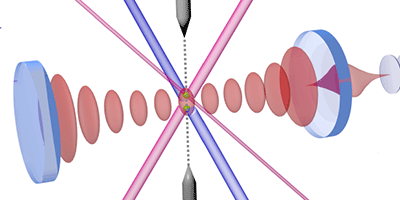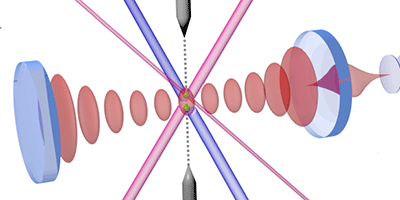A Cavity Just for Two
Over the last decade, physicists have been studying single atoms in optical cavities, where light-matter interactions are strongly amplified. One of the goals is to build interfaces that can connect quantum memory—stored in the atom—with information-carrying photons. Adding more atoms can improve the connection by boosting the light output. To explore this effect at its most basic level, two research groups have confined a pair of emitters—neutral atoms in one case, ions in the other—in a single cavity and observed enhanced (as well as reduced) emission.
The experiments demonstrate a well-known collective behavior exhibited by multiple emitters. When N closely assembled atoms or ions interact with a light field, interference effects can lead to superradiant (or subradiant) emission, which is greater (or less) than the sum of N separate emitters. In most instances, N is a large number, but now superradiance and subradiance have been observed for the first time in a cavity with N equals 2. This “bottom-up” approach makes more evident the emitter-emitter interaction and reveals potential competing effects (such as cavity-emitter interactions).
In the first case, René Reimann from the University of Bonn in Germany and his colleagues captured two neutral cesium atoms in a magneto-optical trap and then shuttled them into a cavity defined by two mirrors. The team recorded the scattering emission from the atoms and found evidence of both enhanced and suppressed emission, depending on the spatial separation of the atoms in the cavity. Independently, Bernardo Casabone from the University of Innsbruck in Austria and his collaborators performed their cavity measurements on two trapped calcium ions, which they entangled together with light beams. In one entanglement configuration, the ions emitted superradiantly, whereas in another, they emitted subradiantly. The team then encoded one qubit of information into their ion pair. With the superradiant emission, the information could be transferred to a photon with less error than for a single-ion qubit.
–Michael Schirber
This research is published in Physical Review Letters.





